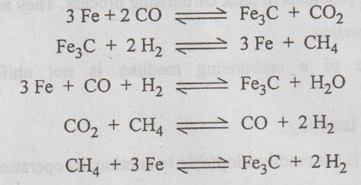Gas carburising overcomes the drawbacks/difficulties of pack carburising by replacing the solid carburising mixture with a carbon-providing gas.
GAS CARBURIZING
1. What is Meant by Gas Carburising?
✓ Gas carburising overcomes the drawbacks/difficulties of pack carburising by replacing the solid carburising mixture with a carbon-providing gas.
✓ Gas carburizing can be done with any carbonaceous gas (i.e., gas containing an excess of CO). In general, natural gas, propane, or generated gas atmospheres are most frequently used.
2. Procedure
The gas-carburizing is carried out in both continuous or batch-type furnaces. In this process, the components are heated (at about 900°C) in a furnace in which the carburising gas which is rich in carbon, such as methane, propane, or butane is circulated. The horizontal rotary type of gas carburising furnace has a muffle or retort which revolves slowly, so that the components are rotated in the stream of the gas. The carburising gas contains CO and hydrocarbons which decompose at red heat and deposit the carbon on the component surfaces.
The thickness of the case formed depends upon the rate of flow of the gases and the temperature.
3. Mechanism/Reactions during Gas Carburising Process
The major reactions that take place during the process of gas carburising are given below:

Thus, like in pack carburising, the formation of Fe3C on the surface gives a very high hardness to them.
4. Application
Gas carburising is widely used for large-scale treatment, particu- larly for the mass production of thin cases.
Note
It may be noted that the gas carburising is really. a form of pack carburising except that the carburising gas comes from hydrocarbon gases instead of from activated charcoal.
No comments:
Post a Comment